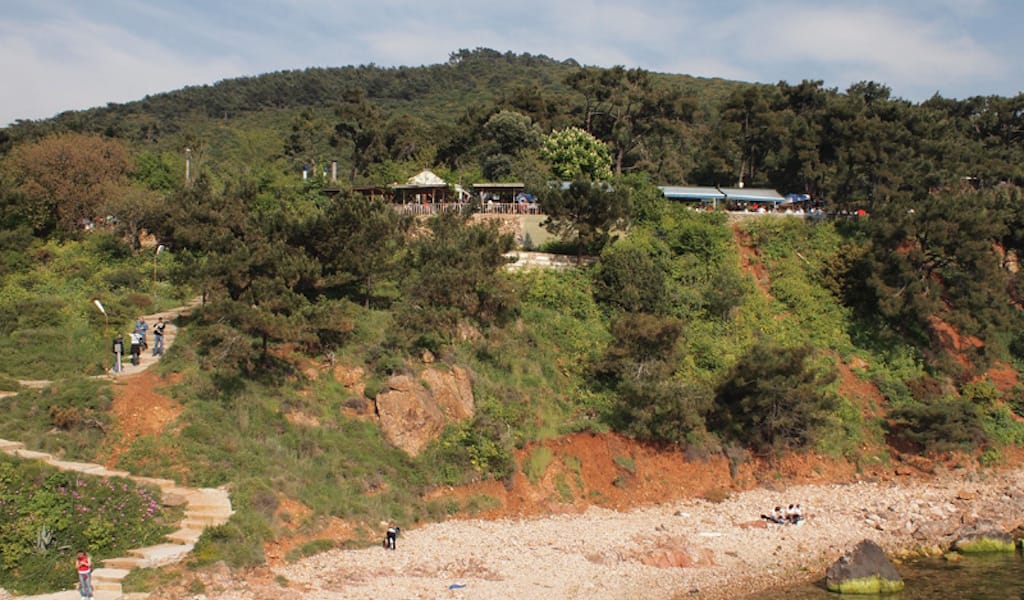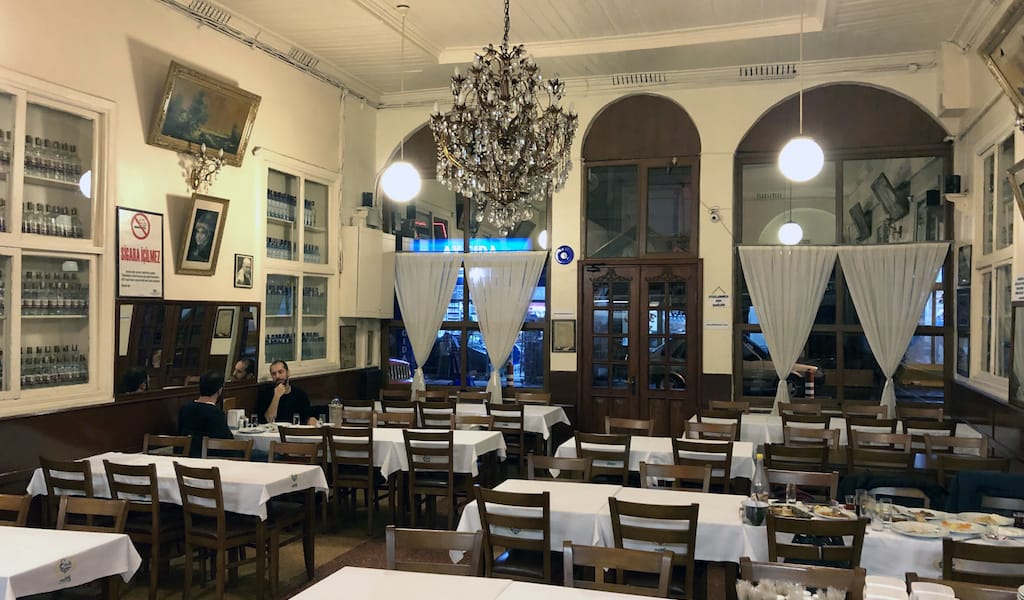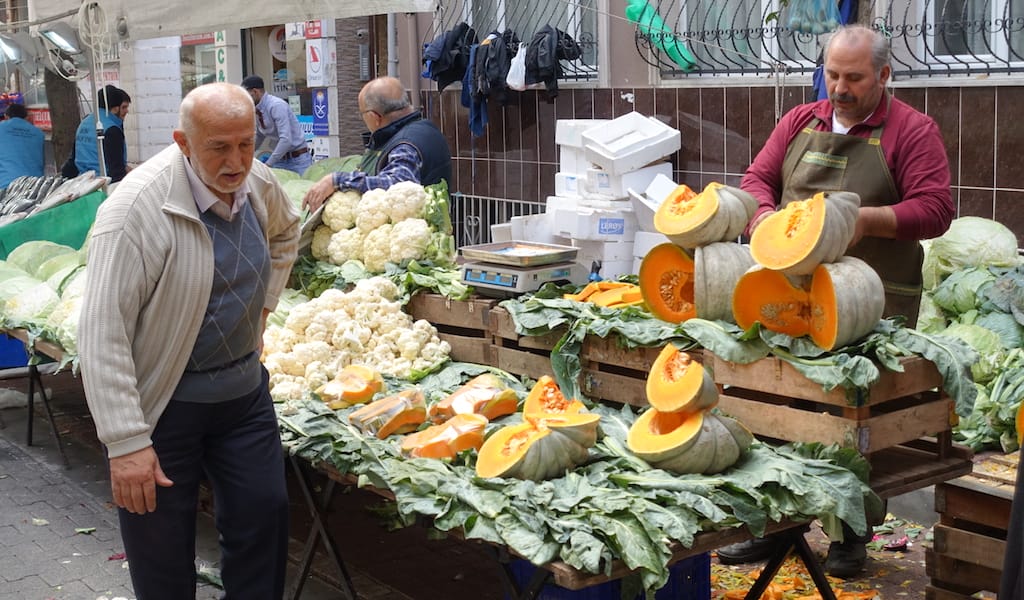Büyükada has long been a popular destination for İstanbullus seeking a break from harried metropolitan life. With its array of quaint köşkler (Ottoman-era wooden mansions), walkable woods and relative quiet (automobiles are prohibited, so there’s none of the modern world’s ubiquitous, underlying machine hum), this five-square-kilometer island, about an hour’s ferry ride southeast of the city center, serves as a welcome counterpoint to the bustle and bother of existence in an urban agglomeration of 14 million. There’s just one problem: The dining scene is insipid. There’s no shortage of fish restaurants along the esplanade, just east of the ferry terminal, but in our experience they’re undistinguished – indeed, indistinguishable – and maddeningly overpriced: in short, tourist traps. Some of the boutique hotels offer reasonable, if unexciting, fare on-site, but if you want to dine out, that row of uninspired seaside eateries is the only game in town.
Or so we thought, before we discovered Prinkipo, as this hidden gem of a meyhane is formally known – after the old Greek name of the island – though no one actually calls it that. Customers, aficionados and friends (visit often enough, and you’re bound to progress from former to latter) refer to it simply as Fıstık Ahmet’in Yeri (“Pistachio Ahmet’s Place”). The proprietor and namesake, Ahmet Tanrıverdi, is an islander born and bred, and at this point something of a local institution. (The epithet Fıstık, or Pistachio, comes from a childhood friend, who dubbed him that because of his unusual green eyes; the nickname stuck.)
As a lad, he never dreamed of becoming a doyen of the island and its cuisine; his overriding passion was soccer. Indeed, his love and talent for the game were prodigious enough that he landed a spot on the prestigious youth squad of Galatasaray, one of Istanbul’s most popular teams. For a time, a career in sport seemed possible – much to his father’s dismay. In order to counterbalance his obsession with the game and inculcate respect for the mental as well as the physical virtues – in particular for the written word – his father ordered him to start keeping a diary. As it turns out, that was a fateful injunction.
Under pressure from his father, Fıstık Ahmet eventually gave up soccer in order to attend university, where he studied industry and commerce. Thereafter he got his professional start, not as a sportsman, nor as a restaurateur, but as the owner of a printing house in Istanbul. Yet even as he spent his days turning out manuals, medical packaging and advertisements, he nurtured a passion for food. This, too, had been a preoccupation since childhood – one he had inherited from his mother. Refugees of the Russo-Turkish War of 1877-78, her side of the family hailed from Georgia, a country (justly) famous for its cuisine. Heiress to that tradition, as well as to the local Greek-influenced culture of fish, seafood and mezes, she was both an excellent cook and a repository of culinary lore. When he wasn’t out playing soccer, the young Fıstık Ahmet spent much of his time around her in the kitchen, imbibing recipes – and scribbling them down in his diary.
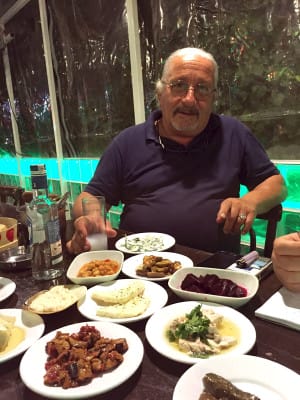 Unlike soccer, neither writing nor love of food ever fell by the wayside. “I’m now 71 years old,” Fıstık Ahmet says, with evident pride, “and I still keep a diary.” Nowadays he’s also an excellent cook in his own right. The latter development had much to do with his prolonged bachelorhood, he admits. He didn’t marry till he was 44, which meant he spent more than two decades cooking for himself, out of necessity – and almost that long for his friends, out of pleasure. He hung out with a cosmopolitan crowd, consisting of Greeks, Armenians and Jews, as well as Turks, who enjoyed long, boisterous dinners well lubricated with rakı, and he found that he enjoyed – and had a knack – for playing host and raconteur. Why don’t you do this for real, his friends implored him? Why not share your cooking with the public? And these stories, the ones you regale us with – why don’t you record them for posterity?
Unlike soccer, neither writing nor love of food ever fell by the wayside. “I’m now 71 years old,” Fıstık Ahmet says, with evident pride, “and I still keep a diary.” Nowadays he’s also an excellent cook in his own right. The latter development had much to do with his prolonged bachelorhood, he admits. He didn’t marry till he was 44, which meant he spent more than two decades cooking for himself, out of necessity – and almost that long for his friends, out of pleasure. He hung out with a cosmopolitan crowd, consisting of Greeks, Armenians and Jews, as well as Turks, who enjoyed long, boisterous dinners well lubricated with rakı, and he found that he enjoyed – and had a knack – for playing host and raconteur. Why don’t you do this for real, his friends implored him? Why not share your cooking with the public? And these stories, the ones you regale us with – why don’t you record them for posterity?
Bowing to their good-natured pressure (and, one imagines, making good use of connections developed in the print trade), Fıstık Ahmet began to publish books. Thus far, he has authored eight, all of them, in some way, celebrations of Büyükada, the neighboring islands and their bygone milieu. (He is currently working on three more, though he’s “being lazy about it,” he says.) Several are memoirs and collections of anecdotes from his youth, when the islands were a bastion of Istanbul’s Christian and Jewish communities; one tells the story of the Greek islanders who decamped for Athens in 1964 to escape the pogrom they feared would follow Cyprus’s so-called Bloody Christmas; another is a history of the island’s Orthodox monastery; yet another is a primer on the archipelago, distributed to its schoolchildren. The rest, fittingly, are about food, in particular, the rakı and meze culture of old Istanbul, when the city retained the air of a cosmopolitan, if somewhat decrepit, entrepôt – a milieu for which he’s clearly wistful – in contrast to the teeming, but more homogenized, megalopolis of today. The best-known of these (at any rate, the one that tops a Google search) is a cookbook of recipes from Barba, his first restaurant, a Greek-themed meyhane that he opened in Nişantaşı – a swank neighborhood that’s home to much of Istanbul’s old-money elite – in 1975.
Fıstık Ahmet turned Barba over to new management some time ago and now focuses his energies exclusively on the small, and utterly charming, Prinkipo – a place that successfully manages to keep alive the meyhane spirit of old that these days is so much harder to find back on the mainland. At first it was something of a sideline, open only for the summer season, but nowadays, since he’s decided to return to the island as a more-or-less full-time resident, it operates year-round. Unlike many meyhanes, which offer a hodgepodge of dishes from all around Turkey, Fıstık Ahmet’in Yeri pays exclusive homage to its proprietor’s local roots. “You can’t find any eastern mezes here,” he says. “I got into this profession because I was opposed to kebab culture taking over Istanbul’s other eating cultures.” Not that there’s anything wrong with kebab, he explains; he just wants to preserve the indigenous cuisine that he feared was being lost as massive urban migration transformed the city over the past several decades.
Fıstık Ahmet’in Yeri has one more peculiarity: It has no bill of fare. Instead, it has a fixed menu: 125 TL per person (around US$43) for dinner, for all one can eat and drink. This, too, was a conscious decision. “Well, you know, everywhere you go, people ask for a menu, people keep a menu, but we just wanted to break that habit,” he explains. In part, this is an aesthetic choice, an assertion of a particular epicurean ethic: “If someone comes here because he trusts me, he should surrender to me,” Fıstık Ahmet argues. But, he admits, it also serves as a selection mechanism, a way of attracting a like-minded crowd. “If a guy comes, for instance, if he walks in, he’s so sure of himself, he asks, ‘Is there a menu?’ I say, ‘There isn’t.’ He says, ‘How come?’ I say, ‘There’s a fixed menu’ – well, I know he’s not going to accept that.” Such a customer would be better off going somewhere else, he says; he won’t enjoy what Fıstık Ahmet is offering, and his grousing will spoil the ambiance for others. “By the way,” he adds, “my wife criticizes this approach. She says this costs us money. But I say” – and here he raises his hand to about eye level – “this is my bar. Only those who pass it should come to my place.” One can’t help but recall what Fıstık Ahmet said of his bachelor days. It’s as if he’s trying to recreate the experience of those bygone dinner parties, of long evenings spent with friends over good food and copious drink, in an atmosphere of convivial sodality.
Much like a dinner party, the dishes on offer at Fıstık Ahmet’in Yeri vary with the seasons – and the host’s mood. A typical evening begins with beer, wine or rakı (whatever and as much as you want) along with 12 to 15 cold mezes – all of which come out as soon as you sit down. A recent visit included green kalamata olives from Edremit marinated with lemon, sun-dried tomato and whole black peppercorns; beets pickled with garlic; chickpeas braised with spinach and celery leaves; taramasalata, a dip of fish roe, lemon and starch; a salad of boiled chicken, lettuce, green apples, capers, mayonnaise and just a hint of curry; lakerda, or pickled bonito; eggplant and tomato şakşuka; sautéed carrot and zucchini in a thick, garlicky yogurt sauce; purslane and cucumber in a thin, tangy yogurt sauce; ezine beyaz peynir, a fine Turkish white cheese similar to feta; yaprak dolma, or stuffed grape leaves, prepared according to an old palace recipe with rice, sour cherries and almonds; creamy braised sheep’s brain; and fava, a purée of broad bean, onion and olive oil. Every dish was exemplary. The last, in particular, bears special mention. One finds fava on the menu of nearly every meyhane; it’s almost never distinguished. All too often it’s bland and mushy – not bad, per se, but nothing to get excited about. Fıstık Ahmet’s fava is the best we’ve ever had, by far: firmer than usual to the fork and ineffably toothsome, with the perfect balance of salt, vegetal sweetness and savory hints of herb and allium.
After 15 or 20 minutes – and hopefully, a glass or two of rakı – the hot mezes begin to appear. On crowded nights, these come out in waves on large trays, from which the waiters serve every patron in turn. Typically three or four in number, in our experience these have included spiced and thinly sliced beef liver; braised chard leaves stuffed with a savory mince of lamb; köfte, or Turkish meatballs; sautéed mushrooms; and börekler, or pastries, filled variously with cheese, shrimp or pastırma (spiced cured beef). In due time, a fresh green salad appears, along with some kind of island fish, and perhaps, if you’re lucky – which is to say, if the day’s catch was good and Fıstık Ahmet felt like preparing it – mussels or shrimp. At some point, owing to the bottomless drinks, you’ll no doubt be compelled to visit the restroom, where, if you’re a man, and understand Turkish, you’ll nod and chuckle over the quotations Fıstık Ahmet has chosen to display over the urinals. These run the gamut from the wry (“A new love means a new problem” – Balzac) to the gnomic (“I’ve met few people who like an aspen tree because it’s straight” – Cenap Şehabettin) to the locally apt (“King and beggar hunger alike” – Montaigne). All the while, the proprietor circulates, chatting up friends, filling glasses and enjoying himself.
At the end of the evening, the check will be delivered with seasonal fruits accompanied by tea or coffee and, if you like, a shot of Fıstık Ahmet’s homemade digestif. On Fridays and Saturdays, you’ll be tempted to linger to enjoy the live music, delivered by his gray-haired, ponytailed friend, who sings a mix of Turkish and international classics, accompanying himself on harmonica and guitar. Weeknights are typically quieter, especially outside the summer months, but even then you’ll have had your fill, and fun – and if you’re anything like us, you’ll already be planning your return.
(photos by Rana Hoffman)
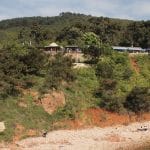 August 13, 2018 Kalpazankaya Restaurant
August 13, 2018 Kalpazankaya Restaurant
One of the great joys of spring and summertime in Istanbul is the chance to get away for […] Posted in Istanbul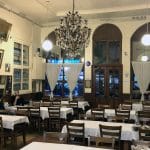 February 6, 2019 Safa Meyhanesi
February 6, 2019 Safa Meyhanesi
The main street of Istanbul’s Yedikule neighborhood is steeped in history: it is dotted […] Posted in Istanbul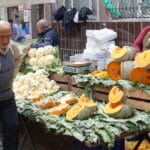 January 27, 2022 The Price Isn’t Right
January 27, 2022 The Price Isn’t Right
Despite the bitter January cold, surging cases of Omicron and roaring inflation, […] Posted in Istanbul
Published on November 30, 2015
Related stories
August 13, 2018
Istanbul | By Culinary Backstreets
IstanbulOne of the great joys of spring and summertime in Istanbul is the chance to get away for a day to one of the Princes’ Islands, the car-free and forested archipelago that is a short ferry ride away from the city. The only downside to an island hop is actually getting there. As soon as…
February 6, 2019
IstanbulThe main street of Istanbul’s Yedikule neighborhood is steeped in history: it is dotted with exquisite buildings built a century ago and passes through a gate that is part of the 4th-century Theodosian walls, parallel to which are a series of historic urban gardens that have been farmed for hundreds of years. Once a well-to-do…
January 27, 2022
IstanbulDespite the bitter January cold, surging cases of Omicron and roaring inflation, Istanbul seemed its usual vibrant self on a recent Friday night: Our first choice restaurant was fully booked, even in its expanded space, and the new neighborhood ocakbaşı where we ended up bustled pleasantly, with every seat taken at the large counter encircling…












































